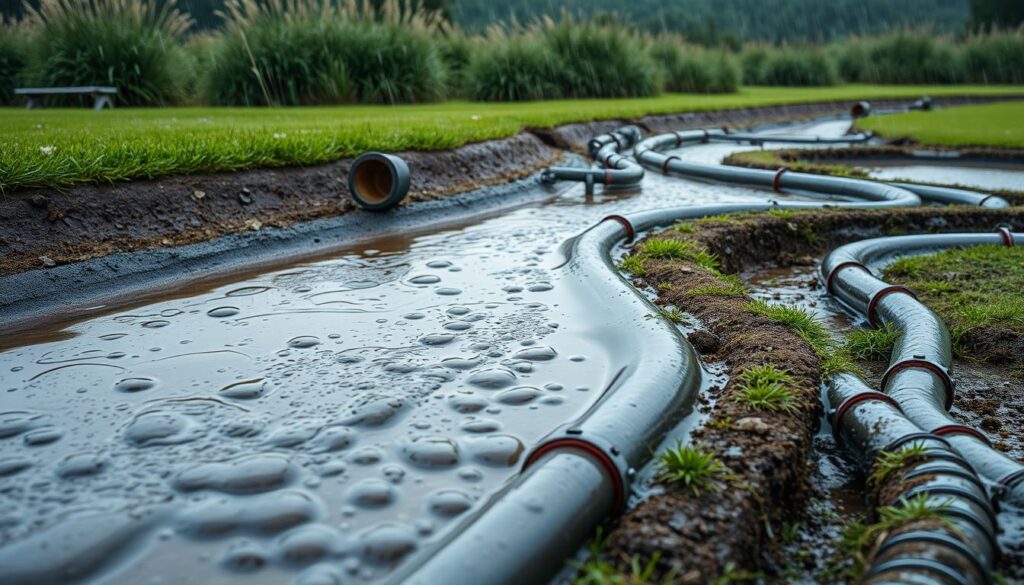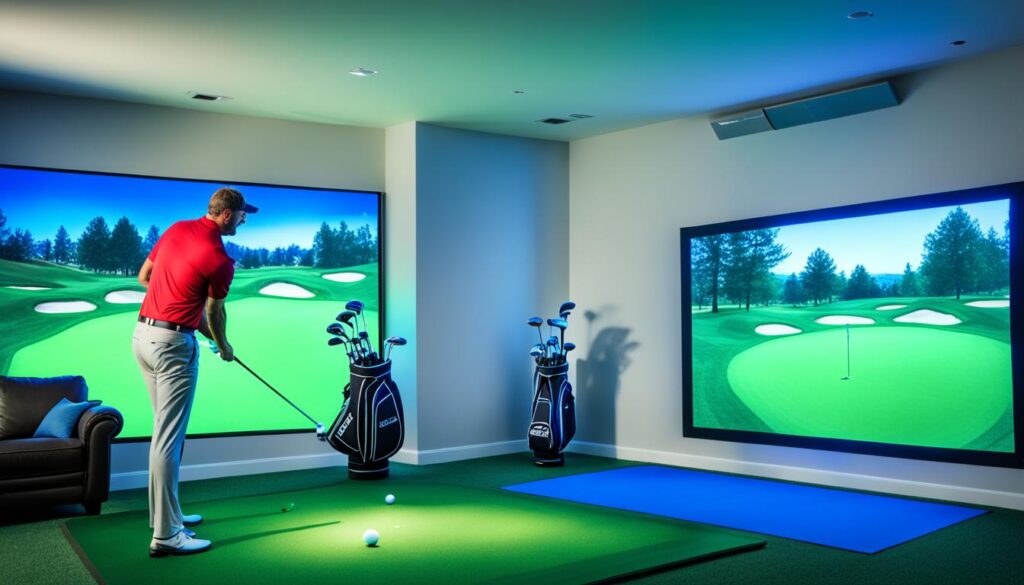Did you know that 70% of golfers in the UK brave the rain during winter months? This fact underscores the dedication of golf enthusiasts. It also sparks a question: do golf courses close for rain? The answer is complex, influenced by the intensity of the rain and the course’s drainage system. Heavy downpours and lightning can lead to closures, making it essential to understand these policies before planning your next game and considering greens fees.
Golf courses close gradually in bad weather, starting with banning golf carts and escalating to full shutdowns if conditions worsen. The decision hinges on rainfall intensity, drainage, and safety. Notably, most courses do not offer refunds for rainouts, so it’s wise to check the forecast before booking.
When planning your golf outing, pay close attention to green fee details and booking information. Some courses have specific policies for rainy days, impacting fees and availability. Having the right gear, like rain gloves and waterproof clothing, can significantly enhance your experience if you play in the wet.
Key Takeaways
- Light rain often doesn’t stop play, but heavy rain with lightning can close courses
- Courses typically close in stages, starting with cart bans
- Most golf courses don’t offer rain refunds
- Proper rain gear can greatly improve your wet-weather golfing experience
- Understanding course policies and checking weather forecasts is crucial
Table of Contents
Introduction

Golf is a sport deeply intertwined with nature, making weather a pivotal element in its enjoyment. Rain can transform a course, presenting unique challenges and altering play dynamics. It’s essential to grasp how weather impacts golf course operations to navigate these conditions effectively.
Weather’s Impact on Golf Course Operations
Rain influences more than your swing; it affects course playability, safety, and maintenance. Wet conditions can turn standout holes into waterlogged hazards, impacting both your game and the course’s integrity. Golf course managers must balance player experience with long-term course care.
Importance of Closure Policies
Knowing a course’s rain policy is crucial for planning your game. Some courses remain open during light rain, while others close at the first drop. These decisions often hinge on factors like drainage systems and soil conditions. Understanding these policies helps you avoid disappointment and prepare for potential challenges.
What to Expect from This Guide
This guide will look at the factors influencing rain-related closures, why some courses stay open in wet weather, and how to prepare for rainy day golf. We’ll also discuss potential risks and typical course policies. Whether you’re a fair-weather golfer or a rain-or-shine player, you’ll gain insights to enhance your golfing experience, regardless of the weather.
| Course Type | Weekday Rates | Weekend Rates | Tee Times |
|---|---|---|---|
| Public Course | $40 – $60 | $60 – $80 | 6:00 AM – 6:00 PM |
| Semi-Private | $70 – $100 | $100 – $130 | 7:00 AM – 5:00 PM |
| Resort Course | $150 – $200 | $200 – $250 | 8:00 AM – 4:00 PM |
Factors Influencing Golf Course Closures Due to Rain

Rain can significantly impact golf course operations, affecting membership details and guest access. Understanding these factors helps players prepare for potential closures and appreciate the challenges courses face in maintaining their amenities.
Course Design and Drainage Systems
A golf course’s layout and drainage capabilities play a crucial role in handling rainfall. Courses with advanced systems can often remain open in conditions that would close others. This ability to manage water flow is an important benefit for members and guests alike.
Intensity and Duration of Rainfall
The amount and persistence of rain greatly influence closure decisions. Heavy, prolonged downpours can saturate the soil, making the course unplayable and vulnerable to damage. This impacts not only the current day’s play but potentially future rounds as well.
Soil and Turf Conditions
The type of soil and health of the turf are critical factors. Sandy soils drain better than clay, while healthy grass can withstand more moisture. These elements affect how quickly a course can recover from rain, influencing closure frequency and duration.
| Factor | Impact on Closure | Member Benefits |
|---|---|---|
| Advanced Drainage | Reduced closure frequency | More play days |
| Soil Type | Affects recovery time | Consistent course conditions |
| Rainfall Intensity | Determines immediate playability | Flexible tee times |
Golf courses strive to balance member satisfaction with course preservation. While 89% of courses faced increased closures due to recent weather, 61% of golfers remain committed to their season plans. This resilience highlights the enduring appeal of golf, even in challenging conditions.
Why Some Golf Courses Remain Open During Rain

Golf courses often stay open during rain, surprising many players. This practice stems from a mix of factors, including advanced technology, smart management, and player desires. Next we will look at why you might find yourself teeing off even when the skies open up.
Advanced Drainage Technology
Modern design features play a crucial role in keeping courses playable during wet weather. Many golf courses now boast state-of-the-art drainage systems that quickly remove excess water. These systems allow fairways and greens to remain firm and playable even after a downpour.
Course Management Practices
Smart course management is critical to staying open during rain. Groundskeepers use specialized techniques to protect the turf and maintain good playing conditions. They might adjust mowing heights or apply treatments to help the grass withstand moisture. These practices ensure the course remains in good shape, preserving its unique features and stunning views.
Player Preferences and Expectations
Many golfers enjoy playing in light rain, seeing it as part of the game’s challenge. Course managers often consider these preferences when setting guest policies. Some courses even offer special rates for rainy days, attracting players who don’t mind getting a bit wet. Understanding slope ratings can help you choose a course that matches your skill level, rain or shine.
| Weather Condition | Courses Open | Primary Closure Reason |
|---|---|---|
| Light Rain | 85% | N/A |
| Heavy Rain | 40% | Safety (70%) |
| Thunderstorms | 0% | Lightning Risk |
While many courses stay open in light rain, safety remains the top priority. Heavy rain or lightning will often lead to temporary closures. Always check the course’s website or social media for updates before heading out to play in wet weather.
Potential Risks and Challenges of Playing Golf in the Rain

Golf enthusiasts often dream of perfect days with sunny skies and scenic views. Yet, sometimes Mother Nature has other plans. Playing golf in the rain brings unique risks and challenges that can affect your game and the course itself.
Safety Concerns
Wet conditions increase the risk of slipping, especially on slopes and greens. Soft spikes in golf shoes are crucial for better traction. Lightning poses a serious threat due to open spaces and metal equipment. Always check weather forecasts before booking tee times.
Course Damage
Heavy rainfall can wreak havoc on golf courses. Excessive moisture leads to waterlogged fairways and damaged greens. In fact, some courses saw a 26% increase in rainfall levels in 2023 compared to the previous year. This often results in course closures for repairs and maintenance of facilities.
Impact on Game Performance
Rain significantly affects your golf game. Wet conditions reduce ball roll and alter club grip. To compensate, take extra club distance, about 5 to 10 yards more. Putting becomes challenging on slower, wet greens. Consider using a golf rangefinder to improve accuracy in these tricky conditions.
| Weather Condition | Impact on Game | Recommended Adjustment |
|---|---|---|
| Light Rain | Slightly reduced ball roll | Use one extra club |
| Heavy Rain | Significantly reduced ball roll, poor grip | Use two extra clubs, wear rain gloves |
| Wet Greens | Slower putting surface | Increase putting backstroke length |
Despite these challenges, with proper preparation and adjustments, you can still enjoy a round of golf even when the weather doesn’t cooperate.
How to Prepare for a Rainy Day on the Golf Course

Rain shouldn’t dampen your golf plans. With the right gear and strategies, you can still enjoy your game on a wet day. Let’s look at how to make the most of a rainy day on the course.
Essential Gear and Equipment
Choosing the right gear is critical for a comfortable round in the rain. Here’s what you’ll need:
- Waterproof golf shoes with soft spikes for better traction
- Rain gloves that improve grip as they get wetter
- Two dry towels to keep hands, gloves, and grips dry
- A double canopy umbrella with over 68″ coverage
- Spare dry clothes for post-game comfort
Strategies for Playing in Wet Conditions
Adjusting your game for wet conditions can help maintain your performance. Consider these tips:
- Take more club, about 5 to 10 yards extra, due to reduced roll
- Wipe clubs before each swing to prevent mud and dirt buildup
- Use more power when putting on saturated greens
- Opt for bump-and-run shots or lofted wedges around the green
Booking a tee time on a rainy day can offer unique benefits. You’ll enjoy more privacy on the course and potentially improve your skills in challenging conditions. Plus, understanding how weather affects your game can give you an edge over other players.
| Weather Condition | Impact on Game | Recommended Strategy |
|---|---|---|
| Light Rain | Slightly slower greens | Adjust putting power |
| Heavy Rain | Reduced ball roll, wet grips | Use rain gloves, take extra club |
| Post-Rain | Softer greens, less roll | Aim more directly at targets |
By preparing well and adapting your game, you can turn a rainy tee time into an enjoyable and rewarding experience. Don’t let a little rain keep you from the course!
Golf Course Policies and Communication
Golf courses have specific policies for rainy days, balancing player experience with course protection. These policies help you plan your game and manage your greens fees expectations.
Typical Closure Policies
Most courses use staged closures during wet weather. They might start by restricting cart use to protect fairways. If rain persists, they may close parts of the course or suspend play entirely. Some courses remain open in light rain, relying on advanced drainage systems to keep the greens playable.
Communication with Players
Effective communication is critical when weather impacts play. Many courses use text alerts or mobile apps to update players on course conditions and closures. It’s wise to check these channels before heading out, especially if rain is in the forecast. Remember, most courses don’t offer refunds for rain, so it’s your job to stay informed about the weather.
Here’s a quick look at some sample greens fees and policies for popular U.S. courses:
| Golf Course | Greens Fees | Rain Policy |
|---|---|---|
| Pebble Beach Golf Links, CA | $575 | No rain checks |
| TPC Sawgrass, FL | $600 | Rain checks available |
| Bethpage Black, NY | $150 (NY residents) | Partial refunds for course closure |
Always check the specific green fee details and policies when booking your tee time. This way, you’ll be prepared for any weather-related changes and can focus on enjoying your round, rain or shine.






